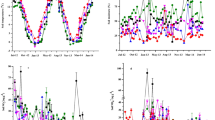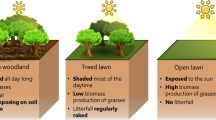Abstract
Purpose
Land use type is an important factor influencing greenhouse gas emissions from soils, but the mechanisms involved in affecting potential greenhouse gas (GHG) emissions in different land use systems are poorly understood. Since the northern regions of Canada and China are characterized by cool growing seasons, GHG emissions under low temperatures are important for our understanding of how soil temperature affects soil C and N turnover processes and associated greenhouse gas emissions in cool temperate regions. Therefore, we investigated the effects of temperature on the emission of N2O, CO2, and CH4 from typical forest and grassland soils from China and Canada.
Materials and methods
The soils were incubated in the laboratory at 10°C and 15°C under aerobic conditions for 15 days.
Results and discussion
The results showed that land use type had a large impact on greenhouse gas emissions. The N2O emissions were significantly higher in grassland than in forest soils, while CO2 emissions were higher in forest than in grassland soils. Grassland soils were weak sources of CH4 emission, while forest soils were weak sinks of atmospheric CH4. The global warming potential of forest soils was significantly greater than that of grassland soils. Soil pH, C/N ratio, and soluble organic carbon concentrations and clay content were dominant factors influencing the emissions of N2O and CO2, respectively. Increasing temperature from 10°C to 15°C had no effects on CH4 flux, but significantly increased N2O emissions for all studied soils. The same pronounced effect was also found for CO2 emission from forest soils.
Conclusions
Indications from this study are that the effects of land use type on the source–sink relationship and rates of GHG emissions should be taken into consideration when planning management strategies for mitigation of greenhouse gas emissions in the studied region, and temperature changes must be taken into account when scaling up point- or plot-based N2O and CO2 flux data to the landscape level due to large spatial and temporal variations of temperature that exist in the field. The reader is cautioned about the limitation with incubation studies on a limited number of samples/locations, and care need to be exercised to extrapolate the result to field conditions.





Similar content being viewed by others
References
Allison SM, Prosser JI (1991) Survival of ammonia oxidizing bacteria in air-dried soil. FEMS Microbiol Lett 79:65–68
Bååth E, Anderson TH (2003) Comparison of soil fungal/bacterial ratios in a pH gradient using physiological and PLFA-based techniques. Soil Biol Biochem 35:955–963
Bodelier PLE, Laanbroek HJ (2004) Nitrogen as regulatory factor of methane oxidation in soils and sediments. FEMS Microbiol Ecol 47:265–277
Booth MS, Stark JM, Rastetter E (2005) Controls on nitrogen cycling in terrestrial ecosystems: a synthetic analysis of literature data. Ecol Monogr 75:139–157
Bowden RD, Newkirk KM, Rullo GM (1998) Carbon dioxide and methane fluxes by a forest soil under laboratory-controlled moisture and temperature conditions. Soil Biol Biochem 30:1591–1597
Bremner JM (1996) Nitrogen-total. In: Sparks DL (ed) Methods of soil analysis, part 3. Chemical methods. Soil Science Society of America, Madison, pp 1085–1121
Bremner JM, Blackmer AM (1979) Effects of acetylene and soil water content on emission of nitrous oxide from soils. Nature 280:380–381
Burford JR, Bremner JM (1975) Relationships between the denitrification capacities of soils and total water soluble and readily decomposable soil organic matter. Soil Biol Biochem 7:389–394
Chantigny MH (2003) Dissolved and water-extractable organic matter in soils: a review on the influence of land use and management practices. Geoderma 113:357–380
Chao CC, Young CC, Wang YP, Chao WL (2000) Daily and seasonal nitrous oxide fluxes in soils from hardwood forest and different agroecosystems of Taiwan. Chemosphere Glob Chang Sci 2:77–84
Cheng W, Tsuruta H, Chen G, Yagi K (2004) N2O and NO production in various Chinese agricultural soils by nitrification. Soil Biol Biochem 36:953–963
Cookson WR, Osman M, Marschner P, Abaye DA, Clark I, Murphy DV, Stockdale EA, Watson CA (2007) Controls on soil nitrogen cycling and microbial community composition across land use and incubation temperature. Soil Biol Biochem 39:744–756
Davidson EA (1991) Fluxes of nitrous oxide and nitric oxide from terrestrial ecosystems. In: Roggers JE, Whitman WB (eds) Microbial production and consumption of greenhouse gases: methane, nitrogen oxides and halomethanes. American Society for Microbiology, Washington, pp 219–235
Del Grosso SJ, Parton WJ, Mosier AR, Ojima DS, Kulmala AE, Phongpan S (2000) General model for N2O and N2 gas emissions from soils due to nitrification. Glob Biogeochem Cycles 14:1045–1060
Dobbie KE, Smith KA (1996) Comparison of CH4 oxidation rates in woodland, arable and set aside soils. Soil Biol Biochem 28:1357–1365
Dörr H, Katruff L, Levin I (1993) Soil texture parameterization of the methane uptake in aerated soils. Chemosphere 26:697–713
Drewitt GB, Black TA, Nesic Z, Humphreys ER, Jork EM, Swanson R, Ethier GJ, Griffis T, Morgenstern K (2002) Measuring forest floor CO2 fluxes in a Douglas-fir forest. Agric For Meteorol 110:299–317
Dunfield P, Knowles R, Dumont R, Moore T (1993) Methane production and consumption in temperate and subarctic peat soils: response to temperature and pH. Soil Biol Biochem 25:321–326
Einola J-KM, Kettunen RH, Rintala JA (2007) Responses of methane oxidation to temperature and water content in cover soil of a boreal landfill. Soil Biol Biochem 39:1156–1164
Freney JR, Denmead OT, Simpson JR (1979) Nitrous oxide emission from soils at low moisture contents. Soil Biol Biochem 11:167–170
Gee GW (2002) Particle-size analysis. In: Dane JH, Topp GC (eds) Methods of soil analysis, part 4. Physical methods. Soil Science Society of America, Madison, pp 280–282
Goodroad LL, Keeney DR (1984) Nitrous oxide production in aerobic soils under varying pH, temperature and water content. Soil Biol Biochem 16:39–43
Gundersen P, Rasmussen L (1990) Nitrification in forest soil: effect from nitrogen deposition on soil acidification and ammonium release. Rev Environ Contam Toxicol 113:1–45
IPCC Climate Change (2007) Changes in atmospheric constituents and in radioactive forcing. http://www.ipcc.ch/pdf/assessment-report/ar4/wg1/ar4-wg1-chapter2.pdf, accessed 17 Jan 2008
Ishizuka S, Tsuruta H, Murdiyarso D (2002) An intensive field study on CO2, CH4 and N2O emissions from soils at four land-use types in Sumatra, Indonesia. Glob Biogeochem Cycles 16:1049–1059
Janssens IA, Lankreijer H, Matteucci G et al (2001) Productivity overshadows temperature in determining soil and ecosystem respiration across European forests. Glob Chang Biol 7:269–278
Jiang QQ, Bakken LR (1999) Nitrous oxide production and methane oxidation by different ammonia-oxidizing bacteria. Appl Environ Microbiol 65:2679–2684
Jones SK, Rees RM, Skiba UM, Ball BC (2005) Greenhouse gas emissions from a managed grassland. Glob Planet Change 47:201–211
Kammann C, Grünhage L, Jäger HJ, Wachinger G (2001) Methane fluxes from differentially managed grassland study plots: the important role of CH4 oxidation in grassland with a high potential for CH4 production. Environ Pollut 115:261–273
Kammann C, Hepp S, Lenhart K, Müller C (2009) Stimulation of methane consumption by endogenous CH4 production in aerobic grassland soil. Soil Biol Biochem 41:622–629
Khalil MI, Van Cleemput O, Rosenani AB, Fauziah CI, Shamshuddin J (2003) Nitrous oxide formation potential of various humid tropic soils of Malaysia: a laboratory study. Nutr Cycl Agroecosyst 66:13–21
Koschorreck M, Conrad R (1993) Oxidation of atmospheric methane in soil: measurements in the field, in soil cores, and in soil samples. Glob Biogeochem Cycles 7:109–121
Lang M, Cai ZC, Mary B, Hao XY, Chang SX (2010) Land-use type and temperature affect gross nitrogen transformation rates in Chinese and Canadian soils. Plant Soil. doi:10.1007/S11104-010-0389-z
Liu H, Zhao P, Lu P, Wang YS, Lin YB, Rao XQ (2008) Greenhouse gas fluxes from soils of different land-use types in a hilly area of South China. Agric Ecosyst Environ 124:125–135
Lou YS, Ren LX, Li ZP, Zhang TL (2007) Effect of rice residues on carbon dioxide and nitrous oxide emissions from a paddy soil of subtropical China. Water Air Soil Pollut 178:157–186
Martikainen PJ, De Boer W (1993) Nitrous oxide production and nitrification in acidic soil from a Dutch coniferous forest. Soil Biol Biochem 25:343–347
Megonigal JP, Guenther AB (2008) Methane emissions from upland forest soils and vegetation. Tree Physiol 28:491–498
Merino A, Pérez-Batallón P, Macías F (2004) Responses of soil organic matter and greenhouse gas fluxes to soil management and land use changes in a humid temperate region of southern Europe. Soil Biol Biochem 36:917–925
Mosier A, Schimel D, Valentine D, Bronson K, Parton W (1991) Methane and nitrous oxide fluxes in native, fertilized and cultivated grasslands. Nature 350:330–332
Qi Y, Xu M (2001) Separating the effects of moisture and temperature on soil CO2 efflux in a coniferous forest in the Sierra Nevada mountains. Plant Soil 237:15–23
Paterson S, Cordero R, Burlinson S (2004) Screening and semi-quantitative analysis of post mortem blood for basic drugs using gas chromatography/ion trap mass spectrometry. J Chromatogr B 813:323–330
Ruser R, Flessa H, Schilling R, Steindl H, Beese F (1998) Soil compaction and fertilization effects on nitrous oxide and methane fluxes in potato fields. Soil Sci Soc Am J 62:1587–1595
Ruser R, Flessa H, Russow R, Schmidt G, Buegger F, Munch JC (2006) Emission of N2O, N2 and CO2 from soil fertilized with nitrate: effect of compaction, soil moisture and rewetting. Soil Biol Biochem 38:263–274
Rustad LE, Huntington TG, Boone RD (2000) Controls on soil respiration: implications for climate change. Biogeochem 48:1–6
Segers R, Kengen SWM (1998) Methane production as a function of anaerobic carbon mineralization: a process model. Soil Biol Biochem 30:1107–1117
Sitaula BK, Bakken LR (1993) Nitrous oxide release from spruce forest soil: relationships with nitrification, methane uptake, temperature, moisture and fertilization. Soil Biol Biochem 25:1415–1421
Smith KA (1980) A model of the extent of anaerobic zones in aggregated soils, and its potential application to estimates of denitrification. J Soil Sci 31:263–277
Smith KA, Ball T, Conen F, Dobbie KE, Massheder J, Rey A (2003) Exchange of greenhouse gases between soil and atmosphere: interactions of soil physical factors and biological processes. Eur J Soil Sci 54:779–791
SPSS Inc. (2000) SPSS for windows, version 13.0. SPSS, Chicago
Steinkamp R, Butterbach-Bahl K, Papen H (2001) Methane oxidation by soils of an N limited and N fertilized spruce forest in the Black Forest, Germany. Soil Biol Biochem 33:145–153
Steudler PA, Bowden RD, Melillo JM, Aber JD (1989) Influence of nitrogen fertilization on methane uptake in temperate forest soils. Nature 341:314–316
Tang XL, Liu SG, Zhou GY, Zhang DQ, Zhou CY (2006) Soil–atmospheric exchange of CO2, CH4 and N2O in three subtropical forest ecosystems in southern China. Glob Chang Biol 12:546–560
Venterea RT, Rolston DE (2000) Mechanisms and kinetics of nitric and nitrous oxide production during nitrification in agricultural soil. Glob Chang Biol 6:303–316
Verchot LV, Davidson EA, Cattânio JH et al (2000) Land-use change and biogeochemical controls of methane fluxes in soils of eastern Amazonia. Ecosystems 3:41–56
Whalen SC, Reeburgh WS, Barber VA (1992) Oxidation of methane in boreal forest soils: a comparison of seven measures. Biogeochem 16:181–211
Zaman M, Chang SX (2004) Substrate type, temperature, and moisture content affect gross and net mineralization and nitrification rates in agroforestry systems. Biol Fertil Soils 39:269–279
Zhao W, Cai ZC, Xu ZH (2007) Does ammonium-based N addition influence nitrification and acidification in humid subtropical soils of China? Plant Soil 297:213–221
Acknowledgments
Funding for this work was provided by the China Opportunity Fund of University of Alberta and National Natural Science Foundation of China. We thank Carmela Arevalo for assistance in collecting the samples from the Canadian site and Pak Chow for assistance in the laboratory.
Author information
Authors and Affiliations
Corresponding author
Additional information
Responsible Editor: by Nicole Mathers
Rights and permissions
About this article
Cite this article
Lang, M., Cai, Z. & Chang, S.X. Effects of land use type and incubation temperature on greenhouse gas emissions from Chinese and Canadian soils. J Soils Sediments 11, 15–24 (2011). https://doi.org/10.1007/s11368-010-0260-0
Received:
Accepted:
Published:
Issue Date:
DOI: https://doi.org/10.1007/s11368-010-0260-0




